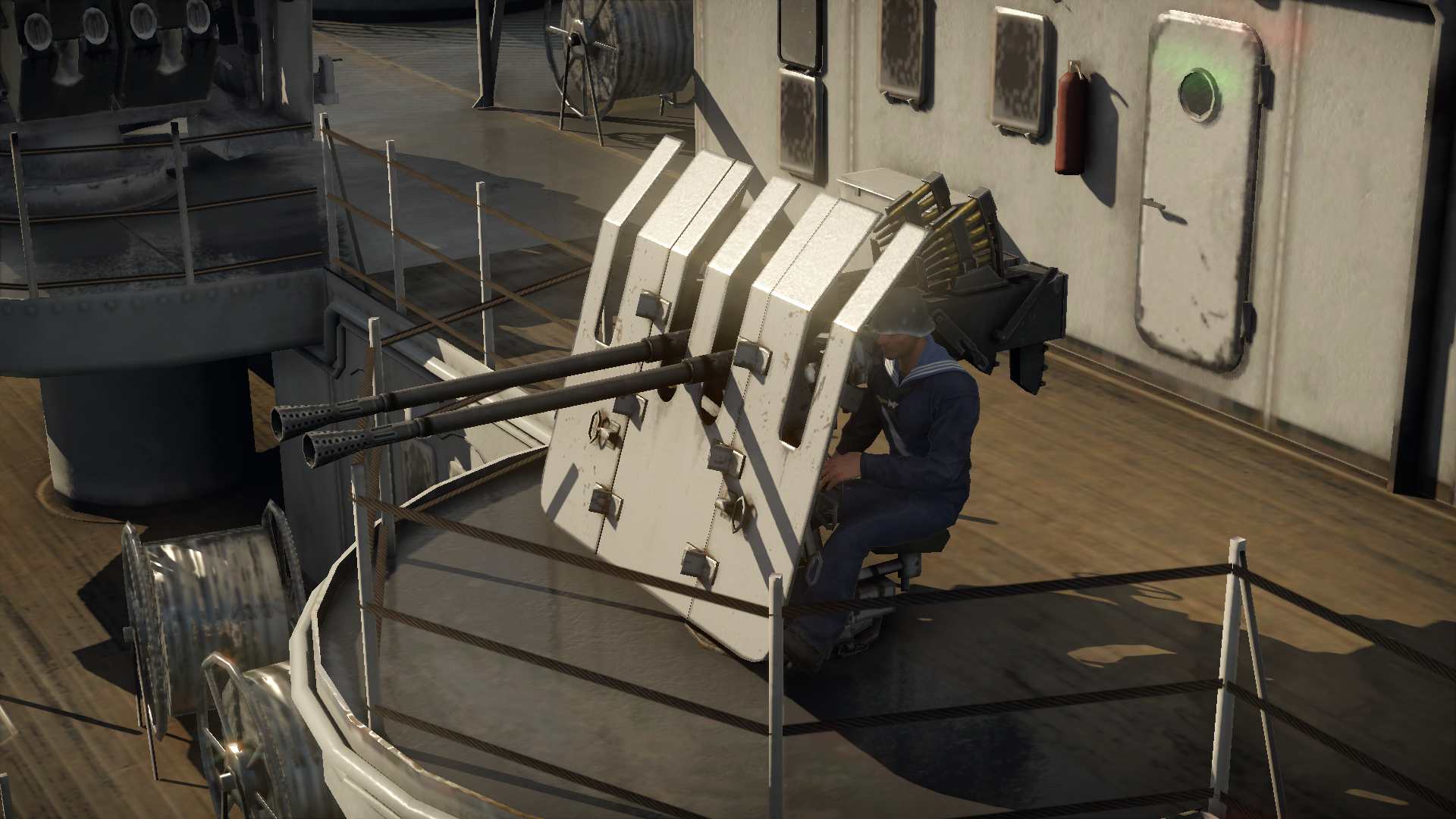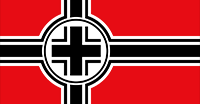3,7 cm FlaK-Lafette LM/42 (37 mm)
Contents
Description
The 3,7 cm FlaK-Lafette LM/42 is a German WWII twin automatic anti-aircraft cannon and is the naval version of the FlaK36 (37 mm). It can be found mounted on the German destroyer Type 1934A (1944). The erroneously named 3,7 cm FlaK-Lafette C/36 (37 mm) is also in the game, both guns being completely identical.
Vehicles equipped with this weapon
General info
The 3,7 cm FlaK-Lafette LM/42 is a twin gun mount that each have a barrel diameter of 37 mm, a barrel length of 2.560 m, and weigh 109 kg. The guns are clip-fed with five-round clips and can fire at a rate of 250 rounds per minute each.
Available ammunition
Depending on the vehicle, there are up to three belts available. The HEF-I round is a tracer.
- Universal: AP-T/HEF-I
- 37 mm HE: HEF-I/HEF-I/HEF-I/HEF-I/AP-T
- 25 mm APT: AP-T/AP-T/AP-T/AP-T/HEF-I
| Penetration Statistics | ||||||
|---|---|---|---|---|---|---|
| Ammunition | Penetration @ 0° Angle of Attack (mm) | |||||
| 10 m | 100 m | 500 m | 1,000 m | 1,500 m | 2,000 m | |
| HEF-I | _ | _ | _ | _ | _ | _ |
| AP-T | 67 | 64 | 55 | 47 | 41 | 37 |
| Shell Details | |||||||||||
|---|---|---|---|---|---|---|---|---|---|---|---|
| Ammunition | Projectile Mass (kg) | Velocity (m/s) | Explosive Type | Explosive Mass (kg) | TNT Equivalent (kg) | Fuse Delay (m) | Fuse Sensitivity (mm) | Normalization at 30° | Ricochet | ||
| 0% | 50% | 100% | |||||||||
| HEF-I | 0.623 | 845.0 | NP 10 | 0.0259 | 0.04403 | 0.0 | 0.1 | _° | _° | _° | _° |
| AP-T | 0.7 | 815.0 | N/A | N/A | N/A | N/A | N/A | _° | _° | _° | _° |
| NP 10 is equivalent to 1.7x TNT. |
Comparison with analogues
The 3,7 cm FlaK-Lafette C/36 (37 mm) is a differently named version of the 3,7 cm FlaK-Lafette LM/42 found on several German minesweepers, destroyers, the anti-air ferry SF40 Leichte, and the light cruiser Nürnberg. Both the LM/42 and the twin mount of the C/36 are completely identical.
The only other German gun of similar calibre is the 3,7 cm SK C/30 (37 mm). Although the 3,7 cm SK C/30 fires heavier and harder-hitting shells, it is a single-shot gun and has a much longer reload. Each gun on the 3,7 cm FlaK-Lafette LM/42 can fire about eight rounds in roughly the 2 second time period it takes the 3,7 cm SK C/30 to fire and reload one. This makes it generally superior in anti-aircraft work and against boats.
Common guns roughly of the same calibre in other nations include:
- 2pdr QF Mk.IIc (40 mm): QF 2pdr guns, and their derivatives, fire stronger HE (0.071 kg TNT equivalence) and have access to HE-DF rounds (in the case of 40 mm/62 "HI" Type 91 AA (40 mm)); but they have a slower muzzle velocity (701 m/s), have a slower a rate of fire (200 rpm), generally have a longer reload, and have weaker AP rounds (42 mm max penetration)
- Bofors L/60 Mark 1 (40 mm): Bofors L/60 guns, and their derivatives, fire stronger AP rounds (69 mm max penetration) and HE rounds (0.0986 kg TNT equivalence), have a faster muzzle velocity (881 m/s); but they have a slower rate of fire (156 rpm), have a smaller magazine size (4 rounds), and can overheat/jam after approximately 50 rounds have been fired.
- 70-K (37 mm): 37 mm 70-K guns fire stronger HE rounds (0.05698 kg TNT equivalence), have a faster muzzle velocity (880 m/s), and don't require reloading until 500 rounds have been fired; but they have a slower rate of fire (150 rpm), generally have a longer reload, and can overheat/jam after approximately 70 rounds have been fired.
Usage in battles
Although each of the 3,7 cm FlaK-Lafette LM/42 have a clip size of only five rounds, the reload is generally so short that it can practically fire continuously. At the same time, unlike other similar guns, the 3,7 cm FlaK-Lafette LM/42 cannot be overheated/jammed if fired for too long, which lets it sustain its virtually continuous fire as long as ammunition is available.
The 37 mm HE clip should be the primary choice for both surface and air targets, since it contains the highest HE:AP ratio. On smaller boats armed with the 3,7 cm FlaK-Lafette LM/42, some 37 mm APT clips should be taken for dealing with armoured targets. On destroyers and cruisers though, if the choice is available, only the 37 mm HE clip should be taken, since armoured targets can be handled by the main guns.
If taking multiple different ammunition choices and the 3,7 cm FlaK-Lafette LM/42 is not the main gun, make sure that the AI gunners fire the 37 mm HE clip so that they are better suited for AA work. Load the 37 mm HE clip first. If 37 mm APT clips are manually loaded, don't forget to switch back to the 37 mm HE clip before switching control away from the armament group.
Pros and cons
Pros:
- Very quick reload
- No overheat/jamming
Cons:
- Low explosive filler
History
The 3.7 cm/69 Flak M42 was designed in 1942 by Rheinmetall-Borsig and entered production and service in late 1943. They were a naval version of the 3.7 cm/57 Flak 36 with a longer 69 calibre barrel. The 3.7 cm Flak M42 had a bore diameter of 37 mm (1.5 in), was 2.560 m (8 ft, 4.8 in) long and weighed 109 kg (240 lbs). The automatics of the gun were driven by a mechanical bolt that operated with the recoil of the gun. The gun had a monobloc, air-cooled barrel design that could be replaced. The 3.7 cm Flak M42 was top-loaded through an ammunition hopper, similar to the operation of the Bofors L/60 gun, and could fire as long as the hopper was filled. The ammunition was manually loaded with five-found ammunition clips, with 0.640 kg high-explosive rounds, 0.635 kg high-explosive tracer rounds, and 0.700 kg armour-piercing rounds available.
The 3.7 cm Flak M42 could either be mounted in single or twin mounts, the latter of which were designated 3.7 cm Flak LM42 and weighed 1.33 tons total. Both mounts included a gun shield and were manually trained and operated. They were used throughout the Kriegsmarine as a successor to the 3.7 cm/83 SK C/30 and were mounted as light ant-aircraft weapons on many destroyers, submarines, and minesweepers. For use on submarines, they were designated 3.7 cm Flak M42U and 3.7 cm Flak LM42U for single and twin mounts, respectively.
Media
An excellent addition to the article would be a video guide, as well as screenshots from the game and photos.
See also
External links
| Germany naval cannons | |
|---|---|
| 15 mm | MG 151 |
| 20 mm | 2 cm/65 C/30 · 2 cm/65 C/38 · 2 cm/65 Flakzwilling 38 · 2 cm/65 Flakvierling 38 · MG 151/20 |
| 30 mm | MK103/38 |
| 37 mm | FlaK-Lafette C/36 · 3.7 cm FlaK-Lafette LM/42 · SK C/30 · FlaK.36 · FlaK43 |
| 40 mm | 40 mm/70 MEL58 · Bofors Flak 28 · Bofors L/70 model 1948 |
| 52 mm | 52 mm/55 SK L/55 |
| 88 mm | 8.8 cm/76 SK C/32 · S.K.C/35 · FlaK.18 · Flak.36 · 88 mm/45 AA SK L/45 · 88 mm/45 casemate SK L/45 |
| 100 mm | 100 mm/55 MLE model 53 |
| 105 mm | SK C/32 · SK C/33 AA |
| 120 mm | L45 |
| 128 mm | 12.8 cm/45 SK C/34 · 12.8 cm SK C/41 |
| 150 mm | 150 mm/45 SK L/45 · 15 cm/48 KC/36 · 15 cm/55 SK C/28 · 15 cm/60 SK C/25 |
| 203 mm | 20.3 cm/60 SK C/34 |
| 283 mm | 283 mm/45 SK L/45 · 283 mm/52 SK C/28 · 283 mm/54,5 SK C/34 |
| 305 mm | 305 mm/50 SK L/50 |
| 380 mm | 38 cm SK L/45 |
| Foreign: | |
| 23 mm | ZU-23 (USSR) |
| 25 mm | 2M-3 (USSR) |
| 30 mm | AK-230 (USSR) |
| 37 mm | V-11 (USSR) |
| 76 mm | 76 mm/62 OTO-Melara Compact (Italy) |
| 100 mm | 100 mm/56 B-34 (USSR) |





